Customer preferences are constantly shifting with the evolving landscape of technology. Customers now expect interactions with companies across diverse communication channels, including phone, chat, email, and social media. This shift in expectations is driving businesses to add more contact channels to accommodate these preferences.
There are many advantages of having a multichannel or omnichannel contact center. For example, it enhances customer satisfaction by making customer support more accessible. Additionally, it provides a comprehensive view of customer interactions, allowing agents to improve customer experience by delivering more personalized services.
However, the advantages come with their own set of challenges. Customers want their experience across the channels to be seamlessly integrated. They don't want to have to repeat themselves anytime they have to switch channels. So, companies need to link the channels together so customers can easily switch between channels hassle-free.
This brings us to the key difference between multi-channel and omni-channel contact centers. Multi-channel contact centers have multiple channels, which are not integrated, so customers cannot seamlessly switch between channels. Whereas omnichannel contact centers have multiple integrated channels, allowing customers to switch and pick up where they left off.
Multichannel Versus Omnichannel Contact Centers
Multi comes from the Latin word "multus," meaning "multiple." In a multichannel contact center, "multi" refers to using multiple communication channels to interact with customers. A multichannel approach allows customers to choose their preferred method of communication while the company manages each channel separately.
Omni comes from the Latin word "omnis," meaning "all" or "every." In the context of an omnichannel contact center, "omni" refers to a more holistic approach. An omnichannel strategy focuses on providing a seamless and consistent customer experience across all channels. This means customers can start an interaction on one channel and continue it on another without losing context.
An omnichannel strategy aims to unify customer data and interactions across channels, allowing for a more personalized and cohesive experience. Whereas a multichannel strategy solely aims to provide more communication channel options without connecting them.
Most SQM call center clients do not feel their touchpoints are fully integrated. However, 43% of their customers who use multiple touchpoints to resolve the same inquiry or problem thought it was a seamless experience. Given that the touchpoints are not fully integrated, SQM has concluded that the way the agent handled the call made the customer feel it was a seamless experience.
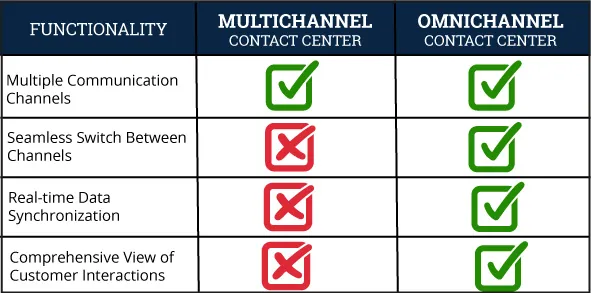
Omnichannel contact centers have higher Csat than multichannel contact centers; however, most customers do not wake up in the morning and say they want to use two contact channels to resolve the same inquiry or problem. In other words, what most customers want is a One Contact Resolution for resolving an inquiry or problem. One Contact Resolution means one channel and one contact to resolve an inquiry or problem.
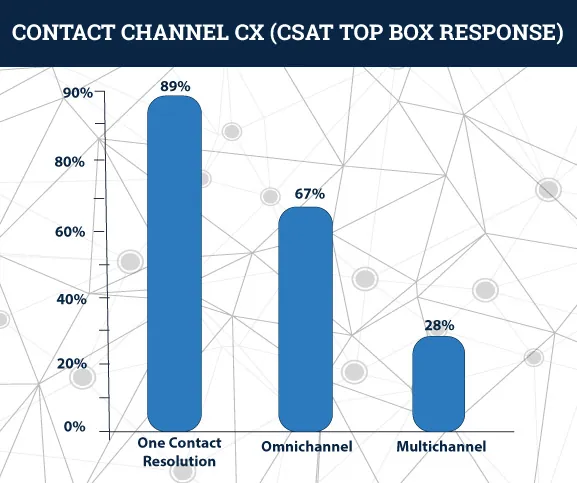
Multichannel Contact Centers
In the past, customer interactions were predominantly handled through a single channel, often just over the phone. However, with the shift towards multiple channels, "call centers" are becoming better known as "contact centers."
With the rise of digital technologies and the increasing popularity of online communication platforms, customers began to expect the flexibility to communicate with companies via their preferred means of communication. The concept of a multichannel contact center emerged as businesses recognized the need to adapt to evolving preferences and habits.
A multichannel contact center facilitates diverse customer interaction channels, such as telephone calls, emails, web chats, SMS/MMS messaging, video meetings, and social media messaging. Nevertheless, these channels might not be entirely interconnected. This implies that if a customer placed a phone call last week and used the live chat today, the agent might not have access to a consolidated view of their complete interaction history.
When customers use another touchpoint, they have to start their inquiry from the beginning, thus having to repeat their previous actions. As a result, SQM research shows that Csat drops by 61% when two or more contact channels are used to resolve the same inquiry or problem compared to customers who experienced One Contact Resolution (OCR).
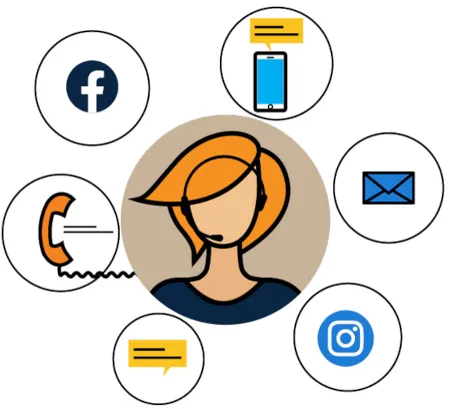
The desire to enhance customer experience drove the evolution of multichannel contact centers to improve efficiency and meet customers where they are most comfortable. As consumers started using various digital platforms to communicate, businesses recognized the importance of creating a consistent and integrated customer service experience across these channels.
Rather than only giving customers the ability to communicate via various channels, businesses wanted to be able to connect these channels to provide agents with a comprehensive view of customer history across all the channels. This led to the development of sophisticated contact center software and tools that could manage interactions across multiple channels. In other words, this led to the idea of an omnichannel contact center.
Omnichannel Contact Centers
Omnichannel contact centers are essentially leveled-up multichannel contact centers. They focus on delivering a seamless and unified customer experience across all channels, allowing customers to switch without losing context or information.
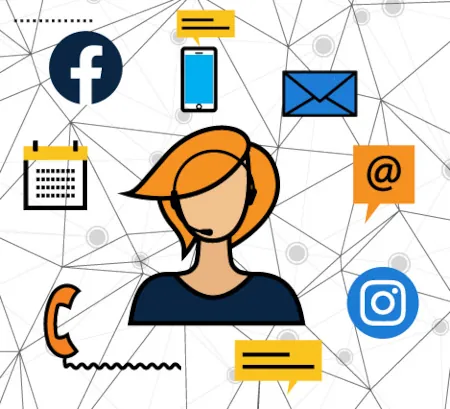
A survey by Verint Systems showcases the popularity of online communication channels such as social media or web chats, particularly with the younger generations who are more familiar with technology and online platforms. 50% of the consumers surveyed have used social media or web chats to contact a company, and 38% have used both. This marks a 14% increase from the previous year's survey.
The omnichannel approach requires robust technology that enables real-time data synchronization and a comprehensive view of customer interactions, allowing agents to understand customer needs better and provide timely, context-aware support.
Here are five benefits of having an omnichannel contact center as opposed to having a traditional call center or even a multi-channel contact center:
- Seamless Customer Experience:
Customers can switch between channels without losing context, ensuring a seamless journey. This contrasts with traditional call centers, where interactions are often limited to phone calls, and multi-channel centers, where interactions might not be well-connected between channels.
- Personalization and Context:
Omni-channel contact centers enable agents to access a complete customer interaction history, regardless of the channel used. This empowers agents to personalize interactions, addressing customer needs more effectively and efficiently.
- Enhanced Agent Efficiency:
Omni-channel contact centers provide agents with a unified interface streamlining interactions across various channels. This reduces the need for agents to switch between different systems, leading to increased efficiency and decreased training time.
- Data-Driven Insights:
Omnichannel centers consolidate customer data from different channels into a central repository, allowing for comprehensive analysis. This facilitates a better understanding of customer behavior, preferences, and pain points, enabling businesses to make informed decisions and refine their strategies.
- Flexibility and Customer Choice:
Omnichannel centers offer customers the flexibility to choose their preferred communication channel. This accommodates varying preferences and habits, enhancing customer satisfaction.
Switching to an omnichannel contact center can benefit your company, but it also has limitations. According to Verint Systems, 46% of businesses consider legacy systems a significant barrier when implementing online communication channels. Legacy systems were not designed to accommodate modern communication demands. These systems often lack integration capabilities, resulting in fragmented customer data across different channels.
Agents struggle to provide adequate assistance without a comprehensive view of a customer's history, leading to disjointed interactions. Moreover, legacy systems' inefficiencies and outdated interfaces can hamper workflow efficiency, impeding agent productivity and frustrating customers.
Furthermore, legacy systems pose scalability challenges, struggling to handle the increased communication volume as businesses expand. These systems' high maintenance costs and security risks can divert resources and expose companies to potential breaches.
Adapting legacy systems to support new channels is complex and time-consuming, inhibiting companies from swiftly meeting evolving customer expectations. A successful transition to an omnichannel model involves carefully evaluating existing systems, strategic investment in modern solutions, seamless data migration, and thorough agent training to ensure a smooth and unified customer experience.
Tips for Setting Up a Multichannel or Omnichannel Contact Center
Before setting up a multichannel or omnichannel contact center, you should evaluate if you really need one. For some companies, particularly smaller ones, a multichannel or omnichannel contact center might not be worth it. It might make no difference to your customers whether they must email you or contact you via social media.
An excellent way to better understand your customers' needs and wants is to use a Customer Service QA Platform such as mySQM™. mySQM™ includes many features, including the customer feedback loop, a process for identifying areas to improve and implementing new practices that will enhance customer service, such as offering multiple contact channels.
Request a mySQM™ Customer Service QA Demo Video
Learn about SQM's agent… Csat prediction model, which is based on standardized metrics, AI, and regression analysis to predict customer satisfaction derived from a QA evaluation. Our Csat prediction model provides a high statistical correlation, translating to a 95% success rate in predicting agent Csat in most cases.
4.6




 Stars on G2 for mySQM™ Auto QA Tool Reviews
Stars on G2 for mySQM™ Auto QA Tool Reviews





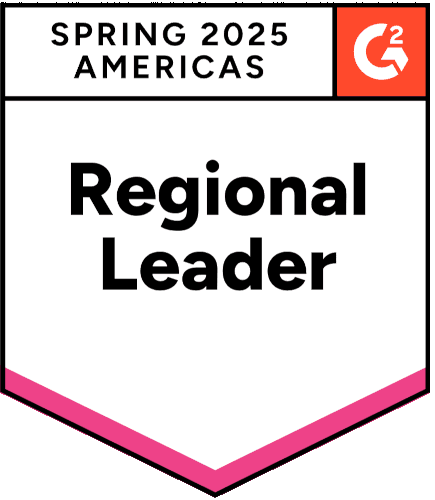






What Differentiates SQM from its Competitors is our...
mySQM™ Automated QA/CX Analytics Solution that uses proprietary AI technology and intellectual property to determine QA scores and predict customer satisfaction with up to 95% accuracy for every call. SQM's Post-Call Customer Satisfaction Prediction QA Model - Is a Game-Changer!
SQM's QA and CSat scores can be used to benchmark against leading call centers. Analyze 100% of customer calls with our auto QA/CX solution.
Furthermore, mySQM™ QA/CX provides agents with self-coaching, self-training, and real-time financial recognition features for calls evaluated to help monitor, motivate, and manage agents to deliver great customer satisfaction.
Once you have evaluated whether your company could benefit from switching to a multichannel or omnichannel contact center, here are some tips to help you make a successful transition.
1. Keep your primary focus on the phone channel
While customers appreciate the convenience of getting customer support via alternate channels such as email and social media, studies have shown that customers prefer to talk to an agent over the phone with more complicated topics.
Therefore, it is essential to prioritize the phone channel by keeping it well-staffed to maintain low wait times and ensure that the agents are well-trained to maintain high Csat and CX. Suppose a customer is already frustrated with having to deal with a complicated issue. In that case, they will likely become very frustrated quickly if they do not receive good customer service over the phone.
2. Train your agents to handle multiple channels
You can easily manage many channels with fewer agents by training your agents on all, or most, of the channels your company uses. If the phones get busier, you could pull some agents away from managing emails to help on the phones or vice versa.
Different channels have different requirements for how they need to be handled. For example, customers who reach out via social media or email will not likely require immediate assistance. This means that an agent could focus on the phones during peak hours and then answer emails during quieter hours.
If you train your agents on different channels, it allows your company to have flexibility. If the higher priority channels get busy, you can pull agents from the lower priority channels, such as email or social media, and place them where they are more immediately needed, such as phones or live chat.
3. Focus on the channels that your customers prefer
Ensure you look at your customer demographics and behavior before deciding which communication channels to add to the mix. If you try to cover as many channels as possible, you will likely spread yourself too thin, and none of the channels will be as effective or efficient.


